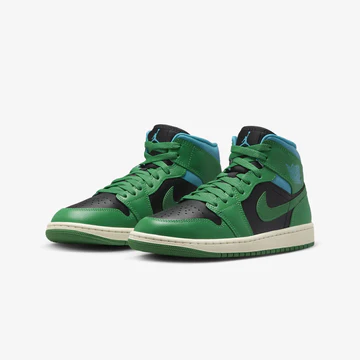The Air Jordan 1 has earned its place in history as not just a revolutionary basketball shoe, but as a cultural icon that has transcended sports and fashion. From its bold debut on the NBA court to becoming a streetwear staple, the Jordan 1 has remained a symbol of style, performance, and identity. Its evolution from the hardwood to the streets has been marked by key moments, collaborations, and cultural milestones that continue to make the Air Jordan 1 one of the most sought-after sneakers in the world.
The Origins of the Air Jordan 1
In 1985, the sneaker world changed forever with the launch of the Air Jordan 1. Designed by Peter Moore, the sneaker broke traditional basketball shoe conventions with its high-top design and vibrant red, black, and white colorway—famously known as the “Bred” colorway. This color scheme violated the NBA’s uniform policy, leading to a $5,000 fine each time Michael Jordan wore them. However, Nike covered the fines, capitalizing on the controversy with the now-legendary “Banned” ad campaign. This bold marketing move catapulted the Jordan 1 into the spotlight, creating a demand unlike any other basketball shoe at the time.
More than just a shoe, the Air Jordan 1 became a symbol of rebellion, individuality, and performance. Michael Jordan’s extraordinary on-court skills, paired with the sneaker’s disruptive design, cemented its place in sports history. The Jordan 1 wasn’t just a shoe; it was a part of Jordan’s journey, and fans wanted to be a part of that story.
The Role of Michael Jordan in Popularizing the Jordan 1
Michael Jordan’s rise to fame played an undeniable role in the success of the Air Jordan 1. His high-flying dunks, clutch performances, and competitive spirit made him a global superstar, and the Jordan 1 became his symbol. Fans connected with Jordan’s on-court dominance, and wearing the Air Jordan 1 allowed them to feel like they were part of his greatness. It wasn’t long before the sneaker made the jump from the basketball court to the streets.
Jordan’s influence extended beyond sports. In urban culture, the Jordan 1 became synonymous with authenticity and self-expression. What started as a performance basketball shoe evolved into a lifestyle sneaker embraced by skaters, musicians, and streetwear enthusiasts.
Iconic Air Jordan 1 Releases and Their Impact on Sneaker Culture
Throughout the decades, the Air Jordan 1 has seen countless notable releases that have shaped sneaker culture. In addition to the original “Bred” colorway, other iconic versions like the “Chicago” and “Royal” have become highly coveted. Limited-edition collaborations with brands such as Off-White, Travis Scott, and Dior have taken the Jordan 1 to new heights, blending high fashion with sneaker culture.
These releases not only sell out instantly but also highlight how the Jordan 1 has become a canvas for artistic and cultural expression. The sneaker’s timeless silhouette makes it a perfect foundation for innovative designs, allowing each iteration to tell a new story while maintaining its classic identity.
The Transition to Streetwear Icon
While the Jordan 1 began its life as a high-performance basketball shoe, its journey into streetwear was almost inevitable. The sneaker’s simple yet bold design made it versatile enough to wear off the court. In the late 1980s and early 1990s, skateboarders in cities like New York and Los Angeles adopted the Jordan 1 for its durability and style, further solidifying its street credibility.
As streetwear culture grew in prominence, the Air Jordan 1 became an essential piece of the uniform. From rappers to fashion designers, influencers to everyday sneakerheads, the Jordan 1 was embraced by all. Its rise in street culture mirrored the rise of sneaker culture, where owning a pair of Jordan 1s became a statement of taste, status, and identity.
Comparisons: Air Jordan 1 vs. Nike Cortez
While the Air Jordan 1 paved its way in basketball and street culture, another Nike classic, the Nike Cortez, followed a similar path in the 1970s. The Nike Cortez, with its sleek, low-profile design, was a staple in Los Angeles street culture and became closely associated with hip-hop and urban fashion. Though not a basketball shoe, the Cortez made its mark in both the athletic and fashion worlds, much like the Jordan 1.
Comparing the Air Jordan 1 and the Nike Cortez highlights how different sneakers can shape culture in distinct ways. The Cortez was embraced for its simplicity and casual aesthetic, while the Jordan 1 was celebrated for its boldness and versatility. Both shoes have become iconic in their own right, influencing generations of sneaker lovers.
Collaborations and Limited-Edition Air Jordan 1 Releases
In recent years, collaborations have played a massive role in keeping the Air Jordan 1 at the forefront of sneaker culture. Collaborations with artists like Travis Scott, who added his signature reverse Swoosh, and brands like Off-White, which deconstructed the Jordan 1 for a fresh, modern look, have generated unparalleled hype.
Limited-edition releases are more than just sneakers—they are status symbols. They blur the lines between streetwear and high fashion, showing how far the Jordan 1 has come since its basketball origins. These collaborations continue to elevate the sneaker’s prestige, making each new release an event in itself.
Conclusion: The Legacy of the Air Jordan 1
The Air Jordan 1 started as a basketball sneaker but has grown into something much bigger. It’s a cultural icon, a symbol of rebellion, and a staple in both streetwear and high fashion. From the court to the streets, the Jordan 1 has left an indelible mark on fashion, sports, and culture. Its evolution is a testament to its timeless design, cultural relevance, and ability to adapt to new trends without losing its identity.
As the Air Jordan 1 continues to evolve through collaborations and innovative designs, its legacy remains intact, forever a symbol of excellence and cultural influence. Whether you’re a basketball fan, a sneakerhead, or a streetwear enthusiast, the Jordan 1 holds a special place in the world of sneakers.




